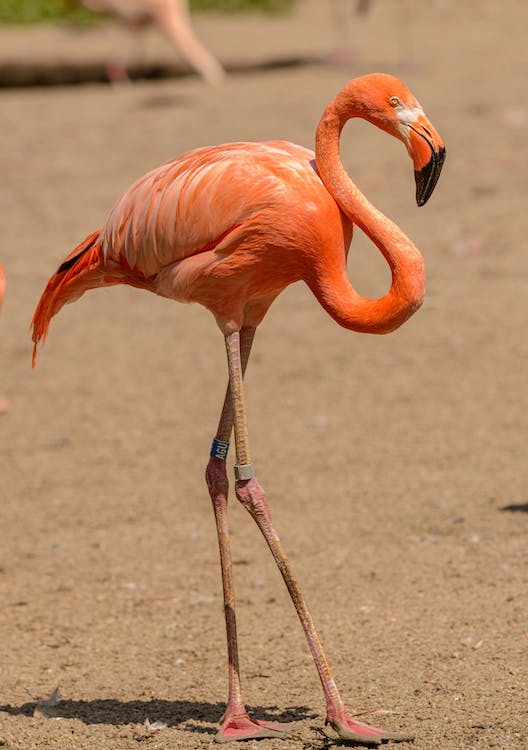The Lesser Flamingo, also known as Phoeniconaias minor, is a flamingo species commonly seen in sub-Saharan Africa, small parts of western Africa, and northwestern India. The name “flamingo” was originally derived from the Portuguese language meaning “red goose,” a reference to the noise they create and their flying formation.
This species is known to be the most numerous species of flamingo and living in the most massive flocks. It was believed that they form flocks that contain one million Lesser Flamingos and several thousand Greater Flamingos.
The Lesser Flamingos was first described by French naturalist Étienne Geoffroy Saint-Hilaire in 1798. Despite being the most populous flamingo species, the International Union for the Conservation of Nature (IUCN) Red List categorized them as Near Threatened due to its decreasing population and limited breeding sites, some of which are jeopardized by human activities.
The population of Lesser Flamingos in the two East African lakes, Bogoria and Nakuru, have been negatively affected in the past years due to what was believed to be heavy metal poisoning. In contrast, its main African breeding area in Lake Natron is threatened by a nearby soda ash plant. Because of the declining population, the Agreement on the Conservation of African-Eurasian Migratory Waterbirds now applies to the Lesser Flamingo.
Its eight levels of scientific classification are as follows:
Domain: Eukaryota
Kingdom: Animalia
Phylum: Chordata
Class: Aves
Order: Phoenicopteriformes
Family: Phoenicopteridae
Genus: Phoeniconaias
Species: P. minor
The physical characteristics of Lesser Flamingo
The Lesser Flamingos can be identified by its long, curved neck and thin, pink legs. Its s-shaped curve is a result of the habit of laying its head along its back when resting. An adult Lesser Flamingo measures between 90 and 125 cm tall, making them the smallest flamingo species. Its webbed feet as three claws. Its plumage ranges from red to pale pink with black primary and secondary wing feathers. Its bill is uniquely shaped, which is specialized for their diet. It is described as deep keeled, angular shape with its upper mandible visible only at the tip.
The distribution and habitat of Lesser Flamingos
Lesser Flamingos are commonly found in western Africa, some parts of central Africa, and southern Africa. They inhabit large alkaline or saline lakes, salt pans, and estuaries that contain high levels of sodium and potassium, as well as calcium and magnesium ions. They are very responsive to changes in their environment, such as fluctuations in chemical and physical aspects, such as the change in conductivity of water.
The behavior of a Lesser Flamingo
Lesser Flamingo are social birds that like living in large flocks, wherein they share social information about the status of predators and food sources around the area. Large flocks make every member less susceptible to predation because several vigilant individuals constantly scan for threats. If an individual senses nearby danger, it will perform an alert display. The other members will mimic this display until they all take flight. After a few minutes, they will return to their habitat when it’s safer.
They are mostly active at night, flying between water bodies in massive, V-shaped formations. When food is abundant, they will fly between sources during the day. They lack senses of smell and taste, making their eyesight and hearing vital senses to their activities. Adults know how to identify chicks by their sounds.
During the breeding season, they form monogamous pairs, and they remain together to raise their young. They breed in colonies with a thousand birds, which usually takes place from October to December. Both male and female Lesser Flamingos will build a nest of mud as high as 30 cm to protect it from flooding. The female only lays one egg, which will be incubated for at least 28 days. Once the egg is hatched, the parents will feed the chick with “crop milk,” a substance that is extracted from an adult Lesser Bird’s upper digestive tract.
The diet of a Lesser Flamingo
These bird species is dubbed as a dietary specialist. It mainly feeds on the microscopic alkaliphilic yanobacteria voronichin Arthrospira fusiformis that contains high levels of protein, lipids, and carbohydrates. A Lesser Flamingo consumes about 72 grams of cyanobacteria a day. It also feeds on various types of algae, copepod, planktonic species, and benthic diatoms.
BOTSWANA BIRDS | SOUTH AFRICA BIRDS
NAMIBIA BIRDS | ZAMBIA BIRDS | ZIMBABWE BIRDS

